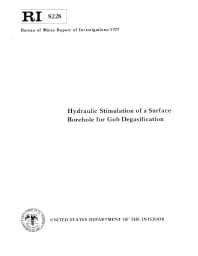Mining Publication: Hydraulic Stimulation of a Surface Borehole for Gob Degasification
Original creation date: January 1977
Authors: SD Maksimovic, CH Elder, FN Kissell
NIOSHTIC2 Number: 10000717
Pittsburgh, PA: U.S. Department of the Interior, Bureau of Mines, RI 8228, 1977 Jan; :1-17
The Bureau of Mines evaluated the hydraulic stimulation of a gob- degasification borehole to determine if this procedure would aid in degasifying a longwall panel. The stimulated borehole did not degasify the longwall panel as expected either before or after mining of the panel started. It reduced the underground methane emission only 11 pct, considerably less than the reductions effected by two unstimulated boreholes in the same panel. Some probable reasons for the reduced methane flow from the hydraulically stimulated borehole are very low reservoir gas pressure, location of hydraulically stimulated zones within the grouted casing, a casing break caused by lateral shifting, possible vertical movement of rock strata during caving, grouting of a 4-inch pipe blocking three stimulated zones, plasticity of shales, and possible hole damage by swelling of water-sensitive minerals. The borehole was also located between two second-mined areas, which may have allowed partial degasification of the overburden and the coalbed in advance of mining. Finally, a period of 3 months is probably not long enough for the borehole to degasify the overburden before mining.

NIOSHTIC2 Number: 10000717
Pittsburgh, PA: U.S. Department of the Interior, Bureau of Mines, RI 8228, 1977 Jan; :1-17
- Coal Mine Methane: A Review of Capture and Utilization Practices with Benefits to Mining Safety and to Greenhouse Gas Reduction
- Comparisons Between Cross-Measure Boreholes and Surface Gob Holes
- Degasification System Selection for U.S. Longwall Mines Using an Expert Classification System
- Methane Drainage: Experience With Hydraulic Stimulation Through Slotted Casing
- A Numerical Evaluation on the Effects of Impermeable Faults on Degasification Efficiency and Methane Emissions During Underground Coal Mining
- Removing Methane (Degasification) from the Pittsburgh Coalbed in Northern West Virginia
- Stochastic Modeling of Gob Gas Venthole Production Performances in Active and Completed Longwall Panels of Coal Mines
- Three Coal Mine Gob Degasification Studies Using Surface Boreholes and a Bleeder System
- Two-Phase Flow in Coalbeds
- Use of Vertical Boreholes for Assisting Ventilation of Longwall Gob Areas